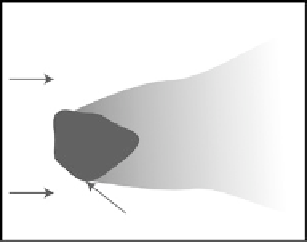Environmental Engineering Reference
In-Depth Information
Groundwater
flow
FIGURE 11.19
Example of natural attenuation of groundwater. (From
United States Environmental Protection Agency (USEPA),
A Citizen's Guide to Monitored Natural Attenuation
, EPA 542-
F-01-004, Office of Solid Waste and Emergency Response,
Washington, DC, 2001b.)
Chemical
11.5.6 Monitored Natural Attenuation
Monitored natural attenuation of contaminants in groundwater is similar to their natural
attenuation in soil. Natural attenuation in groundwater, however, relies upon dilution to
assist in lowering contaminant concentrations and can be effective with certain types of
contaminants provided no continuing source of groundwater contamination exists. This
method also relies on natural physical degradation and natural biodegradation to reduce
contaminant concentrations (Figure 11.19).
11.5.7 Institutional Controls
Institutional controls are used to remove potential receptor pathways, and include the
restriction or prohibition of groundwater use in impacted areas. These measures apply at
locations where groundwater impacts are extensive, or when remediating groundwater is
not practical or cost prohibitive. Institutional controls often require state and local munici-
pality approval.
11.5.8 Multiphase Extraction
Some sites have high concentrations of contaminants present in the subsurface as pure
product. In these cases, there is likely more than one contaminant phase present, including
the vapor phase, dissolved phase, pure product or free phase. The initial effort is focused
on removing the most contaminant mass as quickly as possible—the free product. Other
phases in situ can be removed by the same extraction well. This combination provides
increased efficiency and lowers the cost and time to remove large amounts of contaminant
mass. The technique involves placing multiple types of extraction pumps into the same
borehole to extract contaminants present in each phase (Figure 11.20).
11.6 Summary of Groundwater Remediation Technologies
Selecting the appropriate groundwater remediation technology follows a similar process
as selecting the most appropriate soil remediation technology. The three most important
factors are (1) cost, (2) the geology and hydrogeology where the contaminants reside, and
(3) the physical chemistry of the contaminants targeted for remediation. As with soil
remediation, if a mixture of different types of contaminants is present in groundwater,

Search WWH ::

Custom Search